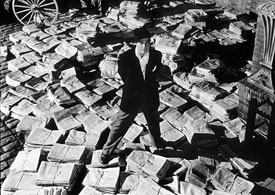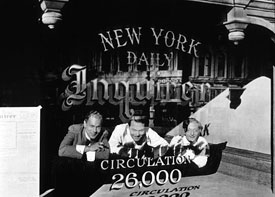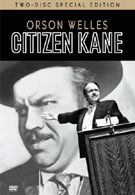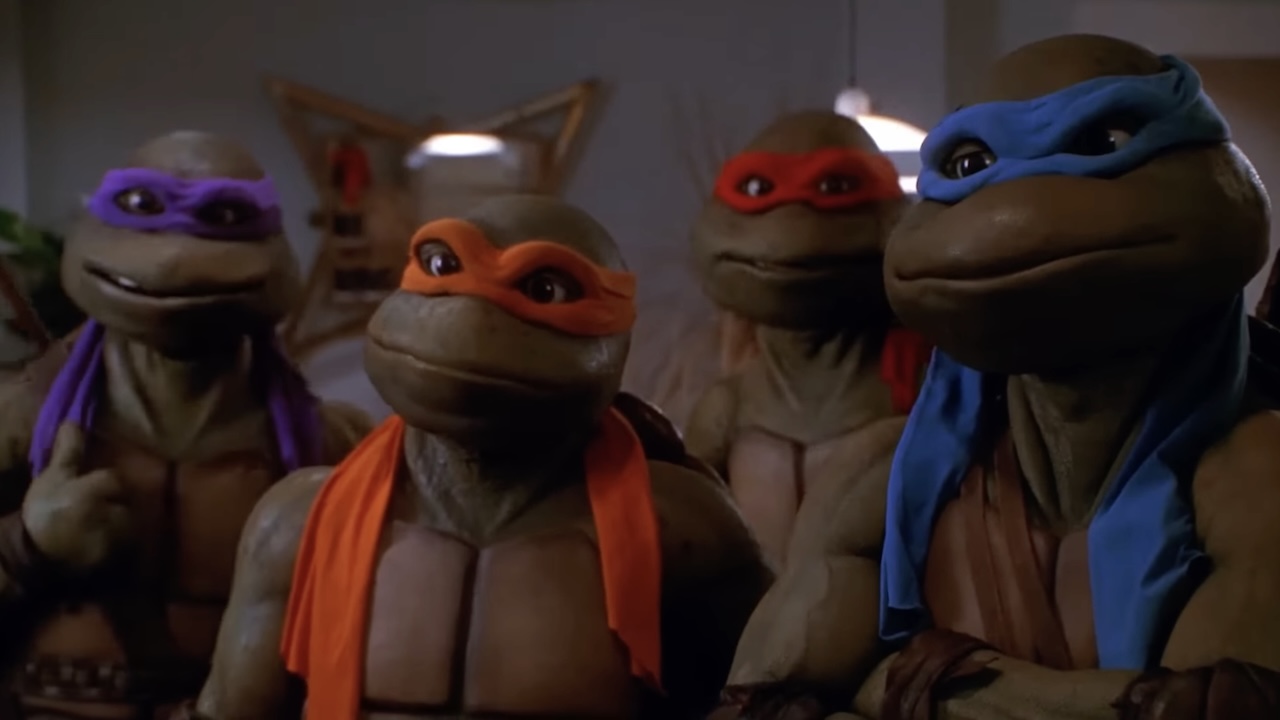What a terrible question: “What is best movie, ever?” You have to qualify the question: what makes a movie good -- and furthermore -- who decides what is good? The answer depends on whom you ask: your baby sister (Spice World), your mentally deranged cousin (Mulholland Drive), or your grandmother (“The one with that man, you know, the tall one, whatshisname, he was in that other movie with the car…”).
If you ask Smart People, Who Know About Movies, And Talk Loudly About Them In Restaurants, you find some discrepancies also. The amazing fountain of cinematographic knowledge “Visions of Light” has a fellow claiming dialogue is immaterial in making a good movie. Only good photography can make a good movie. Obviously, a rather partisan opinion -- but Citizen Kane has both superb cinematography, as well as excellent dialogue.
The fact that the American Film Institute has voted Citizen Kane as the #1 film several times is significant. What makes Citizen Kane good? First off, I’ll start at the other end: What is BAD about Citizen Kane -- it is a short list, and easy to deal with. I can think only of one thing: In some scenes, the actors stare straight into the camera. This is the single bad thing I can say about this film. Apart from that, everything is utterly fantastic.
The cinematography is by Gregg Toland, an absolute master in his field. He did a lot of work with John Ford, but Citizen Kane was sadly the only time he worked with Orson Welles. The opening shot, of Kane’s Xanadu mansion elegantly places the one lit room in a special position of the screen, and keeps it there, the entire time, through all the shots as we approach -- even when the image is a reflection in a pool of water. This sounds unduly pretentious, but the fact is, everyone appreciates a masterful composition, even if they do not know why it looks good. It’s a little like newspaper layout: an amateur with a desktop publishing application can try to make a newspaper, but a layperson with no knowledge of typography, composition and layout can immediately tell that something is wrong with it.
The film also has some very elegant continuous shots, such as the one from Kane’s childhood, where we go all the way from the outside where Kane is playing in the snow, to the inside of his parent’s cabin. The scene where we move through the sign at the roof of a bar where a reporter visits Kane’s mistress is another shot I’ve seen repeated in other movies. There are countless other beautiful shots in Citizen Kane.
Now, although Toland is credited as the Director of Photography, the story goes that Welles -- like most of the rest of the crew -- had never worked on a film before, so he did not know where each crewmember’s responsibilities lay. Welles’ background was in radio and the theatre, where there’s no DP, and thus Welles took on those duties himself. After a while, the crew told Toland he should tell Welles to back off, but Toland told them to not dare say a word: Welles had no idea about the rules of cinematography, and he was breaking them all -- but Toland loved the result. That’s the story, anyhow. The truth is that Toland broke most rules himself. And, he famously told Welles that he would teach him everything he needed to know about cinematography in one weekend. And Welles credited Toland by listing him on the same credit page in Citizen Kane as himself, which was something not done in those days.
There were many other things about Citizen Kane that was not done in films at the time. A small thing was the way the sound from the next scene would start playing a few seconds before the current scene ended. This is a common thing today, and something that nobody notices, but now you know where it came from.
Your Daily Blend of Entertainment News
The narrative style of the film is remarkable. It jumps back and forth in time, yet is never confusing. The strange benefit to this is that upon repeated viewings, the film can still surprise you, since it is hard to remember in what exact sequence the story is told.
Still, what makes the film so amazing to me isn’t merely the film itself -- but also the astounding events that surrounded it.
The film was a scandalous and decrepit tale of the life of William Randolph Hearst, who was one of the world’s most powerful men at the time. Hearst did everything in his power to destroy the film, from trying to buy the negatives so he could burn them, to outright blackmail of the Hollywood community. He did not succeed, but he did come very, very close. Citizen Kane was only shown in a single movie theatre upon its release. It remained a completely unknown film for many years, and it was actually in Europe that it first started receiving recognition as a masterpiece. Such was the power of the Hearst publishing empire.
It speaks volumes about who Orson Welles was: what kind of a madman would go up against Hearst?
Welles was a phenomenon beyond anything ever seen in the movie industry, period. Welles was in his early twenties when he created Citizen Kane. He had never directed, written, nor acted in a film before (in fact, none of the cast, except a small bit part that by accident had never been assigned to anyone, had ever been in a movie before). Sixty years later, many knowledgeable movie experts regard this -- his first movie -- as the greatest masterpiece of the media, ever. This is as if you’ve only ever played tic-tac-toe before, but you beat Gary Kasparov the first time you tried your hand at chess.
Welles and Hearst had more than a few traits in common, which has caused many to observe that Citizen Kane in some cases portrays Welles just as much as it does Hearst. The scene where Kane is asked, “Are you STILL eating?” and replies “I’m still hungry!” could hardly be said to be an accurate portrayal of Hearst, whereas Welles was well known for eating and drinking to extreme excess.
Welles’ portrayal of Marion Davies was extremely vicious. Hearst never built an opera house for her -- that particular act was carried out by another millionaire at the time, for another mistress. It is true that Hearst did push Davies as a serious actress, in spite of her showing no sign of talent for it (she did have a genuine talent for comedy, however). She was by all indications a genuine gold-digger, but her redeeming quality is that she did eventually grow to love Hearst, and sold off all her jewelry and possession to help him out during a financial crisis.
Hearst was never the lonely, grumpy man Citizen Kane portrayed him as. Ironically, Orson Welles would become such character, as he struggled miserably through the rest of his life, in a constant uphill battle to scrounge money for his projects by taking bit parts in lesser movies.
By all accounts, Hearst spent most of his days as a happy man, having met and overcome challenges and succeeded at most he put his hands to. Welles, born half a century later, seemed to be on a parallel destiny after his great successes in the theatre and radio (the infamous War of the World panic was his creation), but Citizen Kane was both his crowning masterpiece, as well as his downfall.
The Citizen Kane DVD is by my reckoning, one of the best values you can buy. It is a 2-disc set, and is loaded with special features, including two full commentary tracks: a decent one by a slightly sycophantic friend of Welles, and a superb one by Roger Ebert. An excellent PBS documentary covers the making of the film, the ensuing fight, as well as the lives of both Welles and Hearst.
For those hungry for more on this fascinating subject, and to understand the extent of Hearst’s power, I recommend the drama on the making of Citizen Kane, RKO 281, starring Liev Schreiber as Welles and John Malkovich as the drunk screenwriter Mankiewicz, and also the recent film The Cat’s Meow about Hearst’s infamous, fatal boat party -- starring the amazing, transvestite Eddie Izzard as Charlie Chaplin.
SPOILER ALERT:
Oh, and a final note: the single-most, famous word in all of movie history -- Rosebud -- was shown in Citizen Kane to be Kane’s beloved sled from his childhood. Thus, the final, and first scene of the film brilliantly ties together this mighty man’s life, showing that for all of his achievements, the only regret he had on his death-bed, was the loss of simple and innocent childhood. In real life, the word was said to be Hearst’s very private and personal nickname for his mistress’ clitoris. No wonder Citizen Kane was attacked so viciously by Hearst: he’d spent his entire life invading and exposing other’s privacy for fun and profit, and did not take lightly to having some whippersnapper in his early twenties turning the tables on him in the winter of his life.



